Towards a Sustainable Zambian Economy
VerifiedAdded on 2021/06/17
|13
|2878
|391
AI Summary
This can be seen from the following figure showing the dynamics in the poverty gap in the country over the years: Figure 1: Dynamics in the poverty scenario of Zambia over the years (Source: Aho.afro.int, 2018) As can be seen to be evident from the above figure, the poverty of the country has not decreased significantly and the level of extreme poverty in the country is still above the target (till 2015) to be reached by the government of the country (De la Fuente,
Contribute Materials
Your contribution can guide someone’s learning journey. Share your
documents today.
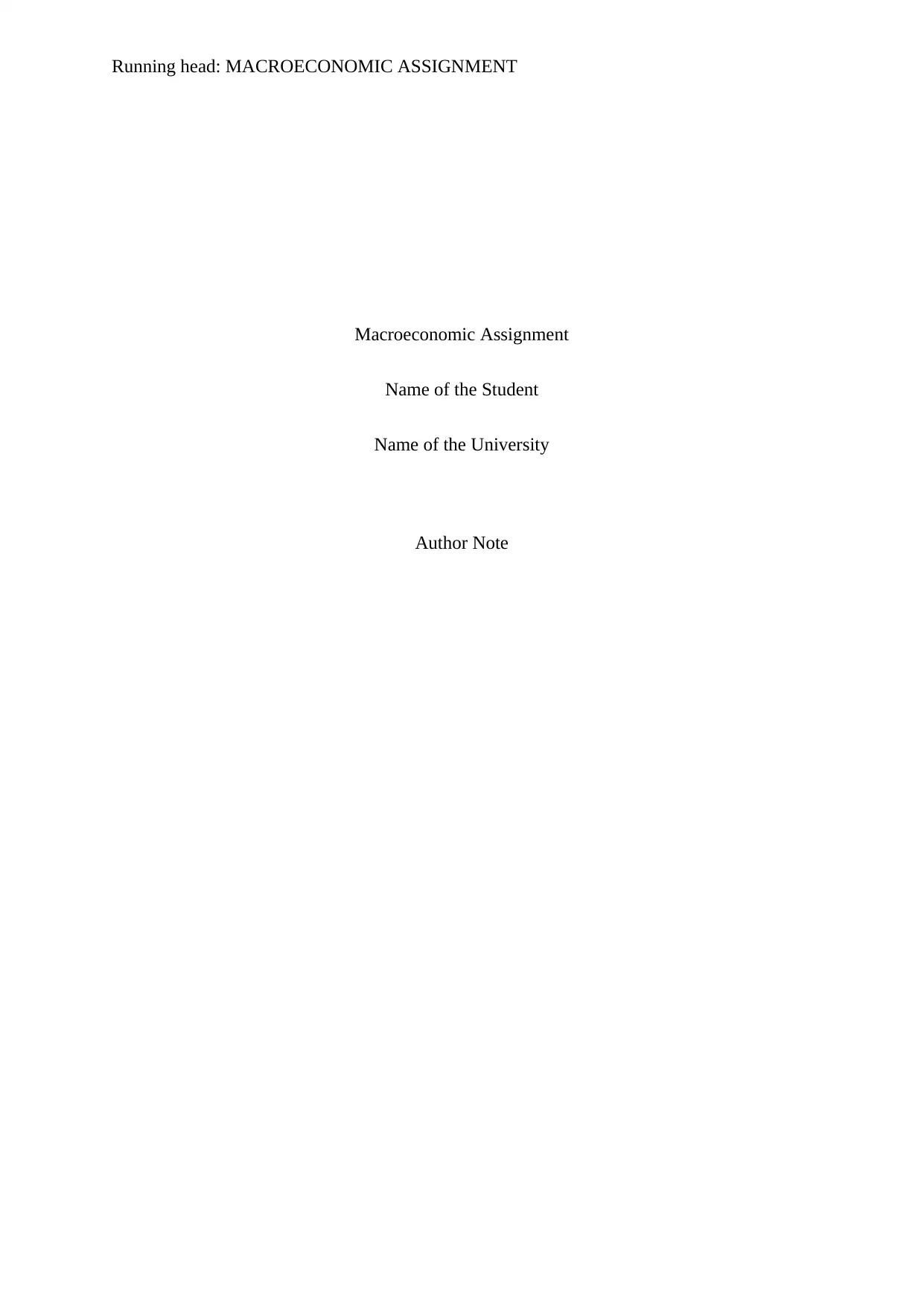
Running head: MACROECONOMIC ASSIGNMENT
Macroeconomic Assignment
Name of the Student
Name of the University
Author Note
Macroeconomic Assignment
Name of the Student
Name of the University
Author Note
Secure Best Marks with AI Grader
Need help grading? Try our AI Grader for instant feedback on your assignments.
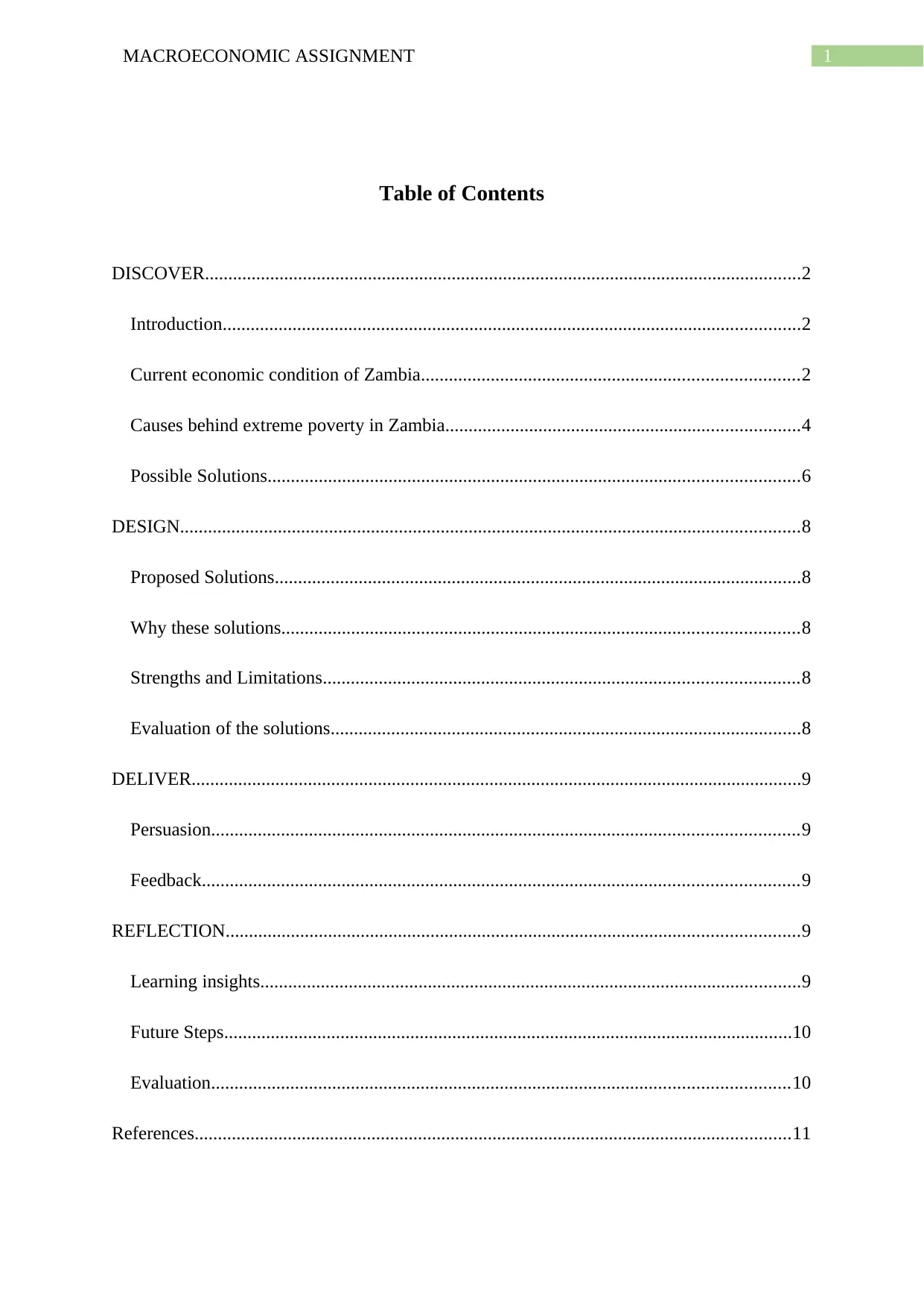
1MACROECONOMIC ASSIGNMENT
Table of Contents
DISCOVER................................................................................................................................2
Introduction............................................................................................................................2
Current economic condition of Zambia.................................................................................2
Causes behind extreme poverty in Zambia............................................................................4
Possible Solutions..................................................................................................................6
DESIGN.....................................................................................................................................8
Proposed Solutions.................................................................................................................8
Why these solutions...............................................................................................................8
Strengths and Limitations......................................................................................................8
Evaluation of the solutions.....................................................................................................8
DELIVER...................................................................................................................................9
Persuasion..............................................................................................................................9
Feedback................................................................................................................................9
REFLECTION...........................................................................................................................9
Learning insights....................................................................................................................9
Future Steps..........................................................................................................................10
Evaluation............................................................................................................................10
References................................................................................................................................11
Table of Contents
DISCOVER................................................................................................................................2
Introduction............................................................................................................................2
Current economic condition of Zambia.................................................................................2
Causes behind extreme poverty in Zambia............................................................................4
Possible Solutions..................................................................................................................6
DESIGN.....................................................................................................................................8
Proposed Solutions.................................................................................................................8
Why these solutions...............................................................................................................8
Strengths and Limitations......................................................................................................8
Evaluation of the solutions.....................................................................................................8
DELIVER...................................................................................................................................9
Persuasion..............................................................................................................................9
Feedback................................................................................................................................9
REFLECTION...........................................................................................................................9
Learning insights....................................................................................................................9
Future Steps..........................................................................................................................10
Evaluation............................................................................................................................10
References................................................................................................................................11

2MACROECONOMIC ASSIGNMENT
DISCOVER
Introduction
The global economic scenario is a diverse and dynamic aspect, with diverse economic
situations in different economies across the globe. Over the years, different countries have
experienced huge economic dynamics and growth in the performance of the different growth
indicators of their economies (Meara et al., 2015). However, the pace and the magnitude of
growth and development has not been the same in all the countries and while countries like
the USA, the European countries, China and Australia have developed considerably and the
Asian countries are developing fast, different countries in the African continent, are still
lagging behind in the aspects of economic growth.
However, in the recent periods these countries are trying to get over their economic
limitations and stagnated situations, by combatting the existing problems to catch up with the
global economic development (Leigh & Blakely, 2016). Keeping this into consideration the
concerned report tries to discuss the economic situation in one such country, Zambia, thereby
discussing the primary economic problems existing the country, the reason behind these
problems and the possible solutions which can be incorporated in this aspect.
Current economic condition of Zambia
Situated in the Southern part of African continent, the country of Zambia is primarily
a landlocked country with limited resources and industrial and commercial aspects in the
country. The primary problem of the economy of the country, is that of the presence of abject
poverty and income inequality in the population of the country, in the contemporary period,
with little progress achieved in this aspect, over the decades (Pieper, Mkandawire & Van der
Hoeven, 2016). This can be seen from the following figure showing the dynamics in the
poverty gap in the country over the years:
DISCOVER
Introduction
The global economic scenario is a diverse and dynamic aspect, with diverse economic
situations in different economies across the globe. Over the years, different countries have
experienced huge economic dynamics and growth in the performance of the different growth
indicators of their economies (Meara et al., 2015). However, the pace and the magnitude of
growth and development has not been the same in all the countries and while countries like
the USA, the European countries, China and Australia have developed considerably and the
Asian countries are developing fast, different countries in the African continent, are still
lagging behind in the aspects of economic growth.
However, in the recent periods these countries are trying to get over their economic
limitations and stagnated situations, by combatting the existing problems to catch up with the
global economic development (Leigh & Blakely, 2016). Keeping this into consideration the
concerned report tries to discuss the economic situation in one such country, Zambia, thereby
discussing the primary economic problems existing the country, the reason behind these
problems and the possible solutions which can be incorporated in this aspect.
Current economic condition of Zambia
Situated in the Southern part of African continent, the country of Zambia is primarily
a landlocked country with limited resources and industrial and commercial aspects in the
country. The primary problem of the economy of the country, is that of the presence of abject
poverty and income inequality in the population of the country, in the contemporary period,
with little progress achieved in this aspect, over the decades (Pieper, Mkandawire & Van der
Hoeven, 2016). This can be seen from the following figure showing the dynamics in the
poverty gap in the country over the years:
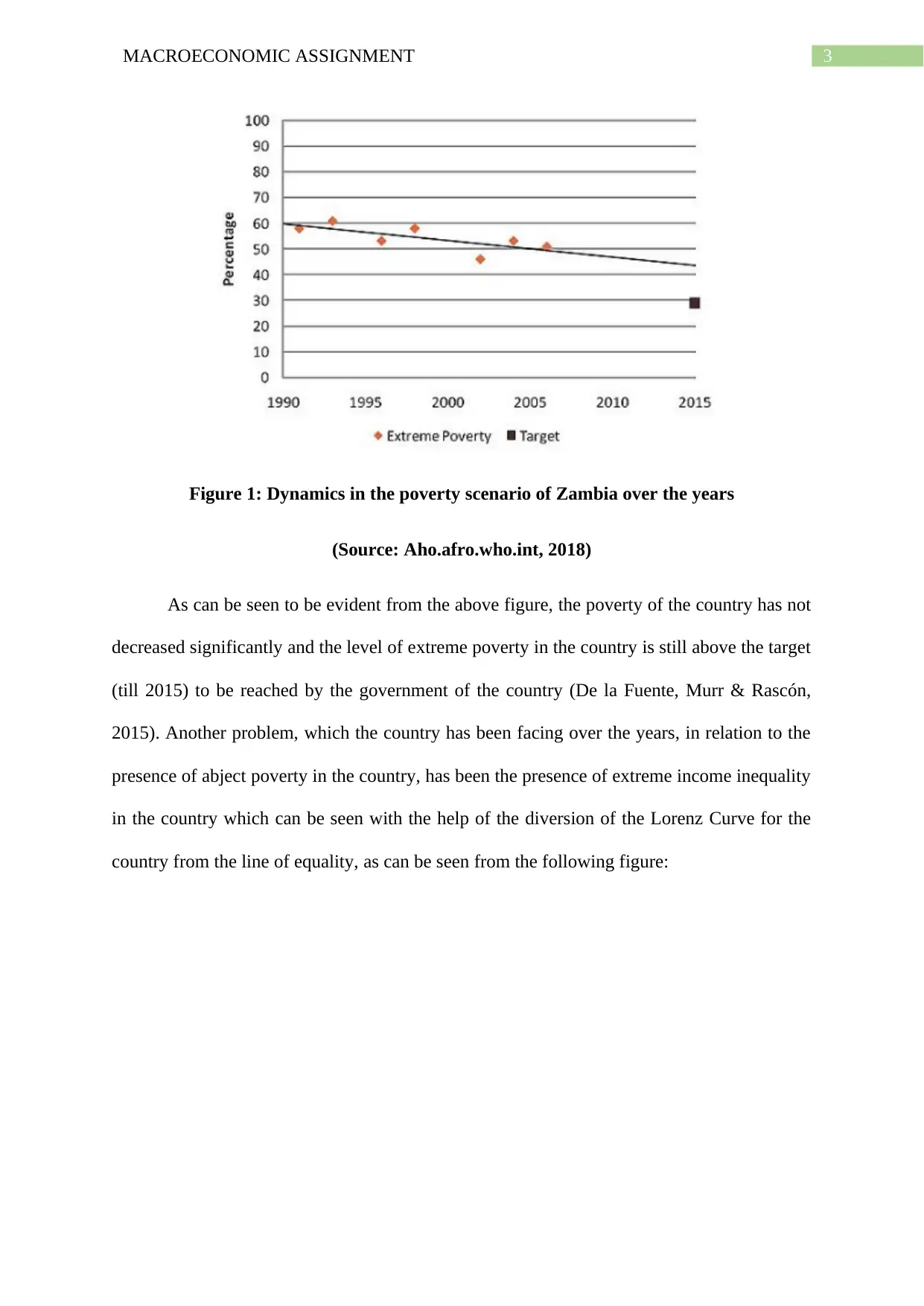
3MACROECONOMIC ASSIGNMENT
Figure 1: Dynamics in the poverty scenario of Zambia over the years
(Source: Aho.afro.who.int, 2018)
As can be seen to be evident from the above figure, the poverty of the country has not
decreased significantly and the level of extreme poverty in the country is still above the target
(till 2015) to be reached by the government of the country (De la Fuente, Murr & Rascón,
2015). Another problem, which the country has been facing over the years, in relation to the
presence of abject poverty in the country, has been the presence of extreme income inequality
in the country which can be seen with the help of the diversion of the Lorenz Curve for the
country from the line of equality, as can be seen from the following figure:
Figure 1: Dynamics in the poverty scenario of Zambia over the years
(Source: Aho.afro.who.int, 2018)
As can be seen to be evident from the above figure, the poverty of the country has not
decreased significantly and the level of extreme poverty in the country is still above the target
(till 2015) to be reached by the government of the country (De la Fuente, Murr & Rascón,
2015). Another problem, which the country has been facing over the years, in relation to the
presence of abject poverty in the country, has been the presence of extreme income inequality
in the country which can be seen with the help of the diversion of the Lorenz Curve for the
country from the line of equality, as can be seen from the following figure:
Secure Best Marks with AI Grader
Need help grading? Try our AI Grader for instant feedback on your assignments.
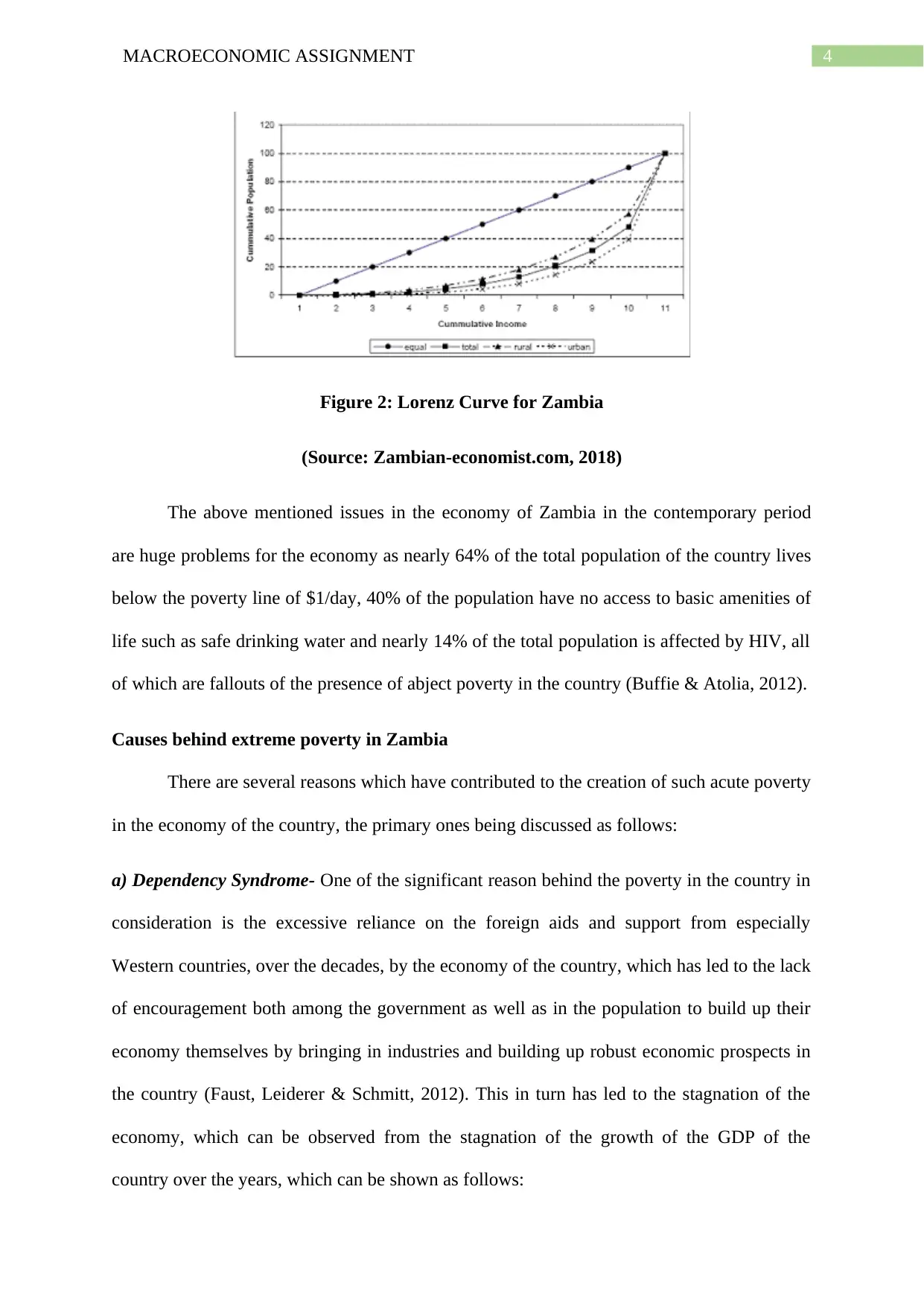
4MACROECONOMIC ASSIGNMENT
Figure 2: Lorenz Curve for Zambia
(Source: Zambian-economist.com, 2018)
The above mentioned issues in the economy of Zambia in the contemporary period
are huge problems for the economy as nearly 64% of the total population of the country lives
below the poverty line of $1/day, 40% of the population have no access to basic amenities of
life such as safe drinking water and nearly 14% of the total population is affected by HIV, all
of which are fallouts of the presence of abject poverty in the country (Buffie & Atolia, 2012).
Causes behind extreme poverty in Zambia
There are several reasons which have contributed to the creation of such acute poverty
in the economy of the country, the primary ones being discussed as follows:
a) Dependency Syndrome- One of the significant reason behind the poverty in the country in
consideration is the excessive reliance on the foreign aids and support from especially
Western countries, over the decades, by the economy of the country, which has led to the lack
of encouragement both among the government as well as in the population to build up their
economy themselves by bringing in industries and building up robust economic prospects in
the country (Faust, Leiderer & Schmitt, 2012). This in turn has led to the stagnation of the
economy, which can be observed from the stagnation of the growth of the GDP of the
country over the years, which can be shown as follows:
Figure 2: Lorenz Curve for Zambia
(Source: Zambian-economist.com, 2018)
The above mentioned issues in the economy of Zambia in the contemporary period
are huge problems for the economy as nearly 64% of the total population of the country lives
below the poverty line of $1/day, 40% of the population have no access to basic amenities of
life such as safe drinking water and nearly 14% of the total population is affected by HIV, all
of which are fallouts of the presence of abject poverty in the country (Buffie & Atolia, 2012).
Causes behind extreme poverty in Zambia
There are several reasons which have contributed to the creation of such acute poverty
in the economy of the country, the primary ones being discussed as follows:
a) Dependency Syndrome- One of the significant reason behind the poverty in the country in
consideration is the excessive reliance on the foreign aids and support from especially
Western countries, over the decades, by the economy of the country, which has led to the lack
of encouragement both among the government as well as in the population to build up their
economy themselves by bringing in industries and building up robust economic prospects in
the country (Faust, Leiderer & Schmitt, 2012). This in turn has led to the stagnation of the
economy, which can be observed from the stagnation of the growth of the GDP of the
country over the years, which can be shown as follows:
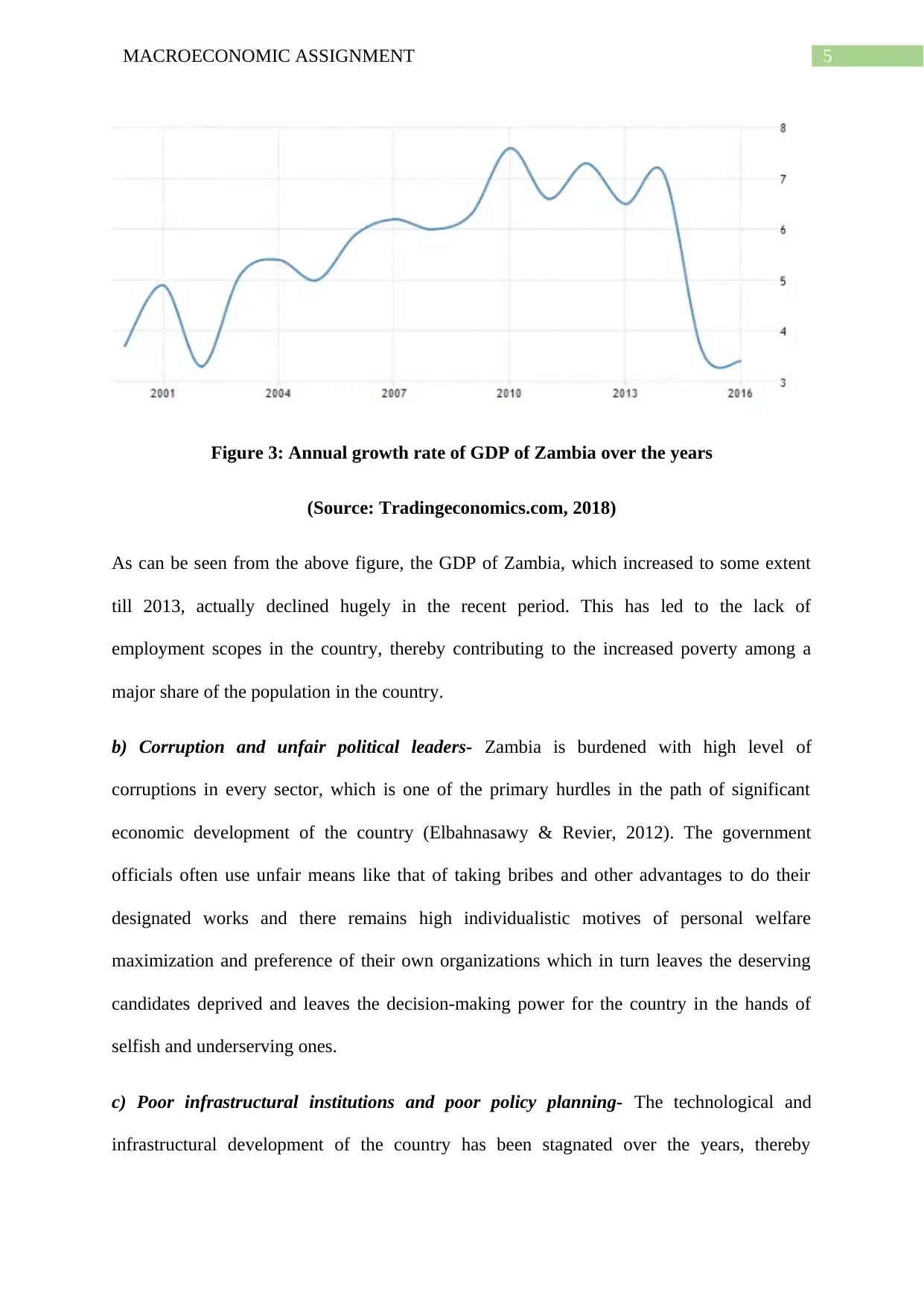
5MACROECONOMIC ASSIGNMENT
Figure 3: Annual growth rate of GDP of Zambia over the years
(Source: Tradingeconomics.com, 2018)
As can be seen from the above figure, the GDP of Zambia, which increased to some extent
till 2013, actually declined hugely in the recent period. This has led to the lack of
employment scopes in the country, thereby contributing to the increased poverty among a
major share of the population in the country.
b) Corruption and unfair political leaders- Zambia is burdened with high level of
corruptions in every sector, which is one of the primary hurdles in the path of significant
economic development of the country (Elbahnasawy & Revier, 2012). The government
officials often use unfair means like that of taking bribes and other advantages to do their
designated works and there remains high individualistic motives of personal welfare
maximization and preference of their own organizations which in turn leaves the deserving
candidates deprived and leaves the decision-making power for the country in the hands of
selfish and underserving ones.
c) Poor infrastructural institutions and poor policy planning- The technological and
infrastructural development of the country has been stagnated over the years, thereby
Figure 3: Annual growth rate of GDP of Zambia over the years
(Source: Tradingeconomics.com, 2018)
As can be seen from the above figure, the GDP of Zambia, which increased to some extent
till 2013, actually declined hugely in the recent period. This has led to the lack of
employment scopes in the country, thereby contributing to the increased poverty among a
major share of the population in the country.
b) Corruption and unfair political leaders- Zambia is burdened with high level of
corruptions in every sector, which is one of the primary hurdles in the path of significant
economic development of the country (Elbahnasawy & Revier, 2012). The government
officials often use unfair means like that of taking bribes and other advantages to do their
designated works and there remains high individualistic motives of personal welfare
maximization and preference of their own organizations which in turn leaves the deserving
candidates deprived and leaves the decision-making power for the country in the hands of
selfish and underserving ones.
c) Poor infrastructural institutions and poor policy planning- The technological and
infrastructural development of the country has been stagnated over the years, thereby

6MACROECONOMIC ASSIGNMENT
depriving the country of the growth in its industrial and economic sectors. The policy
frameworks of the country, on the other hand, are designed with a visible bias towards the
elite class of the country as well as towards the foreign multinational companies who invest
in the sectors profitable to the elite class of the country. This is seen to be reflected in the
rising inequality and poverty among a major share of the country over the years (Potts, 2016).
Notwithstanding the extreme pressure of competition of the foreign companies, many local
businesses had to leave the market, which in turn indicates towards the failure of the
government of the country to develop its own economic and industrial prospects.
d) Brain drain- One of the primary reason behind the low development and poverty in the
country is the high rate of drainage of human capital of the country with the emigration of
highly skilled people like that of doctors, scientists, business people as well as teachers to
other countries with greater prospects. This in turn has left the country resource scarce and
there has been no incentive for the deserving people to stay and work to build up the
economy of the country.
e) Illiteracy- The country has remained acutely poor due to the lack of proper skill
development and unemployment, which in turn can be attributed to the lack of proper
education. With 90% of the female population and a considerable section of the male
population being uneducated, the poverty and suffering of the population of the country has
remained high over the years (Ranis & Stewart, 2012).
Possible Solutions
To deal with the economic issues of extreme poverty and inequality, the following
policies and steps can be implemented by the government of the country:
a) The primary policy which has to be reformed in the country is the unfair policy of
electing the leaders of the country which shows enough individual and personal bias.
depriving the country of the growth in its industrial and economic sectors. The policy
frameworks of the country, on the other hand, are designed with a visible bias towards the
elite class of the country as well as towards the foreign multinational companies who invest
in the sectors profitable to the elite class of the country. This is seen to be reflected in the
rising inequality and poverty among a major share of the country over the years (Potts, 2016).
Notwithstanding the extreme pressure of competition of the foreign companies, many local
businesses had to leave the market, which in turn indicates towards the failure of the
government of the country to develop its own economic and industrial prospects.
d) Brain drain- One of the primary reason behind the low development and poverty in the
country is the high rate of drainage of human capital of the country with the emigration of
highly skilled people like that of doctors, scientists, business people as well as teachers to
other countries with greater prospects. This in turn has left the country resource scarce and
there has been no incentive for the deserving people to stay and work to build up the
economy of the country.
e) Illiteracy- The country has remained acutely poor due to the lack of proper skill
development and unemployment, which in turn can be attributed to the lack of proper
education. With 90% of the female population and a considerable section of the male
population being uneducated, the poverty and suffering of the population of the country has
remained high over the years (Ranis & Stewart, 2012).
Possible Solutions
To deal with the economic issues of extreme poverty and inequality, the following
policies and steps can be implemented by the government of the country:
a) The primary policy which has to be reformed in the country is the unfair policy of
electing the leaders of the country which shows enough individual and personal bias.
Paraphrase This Document
Need a fresh take? Get an instant paraphrase of this document with our AI Paraphraser
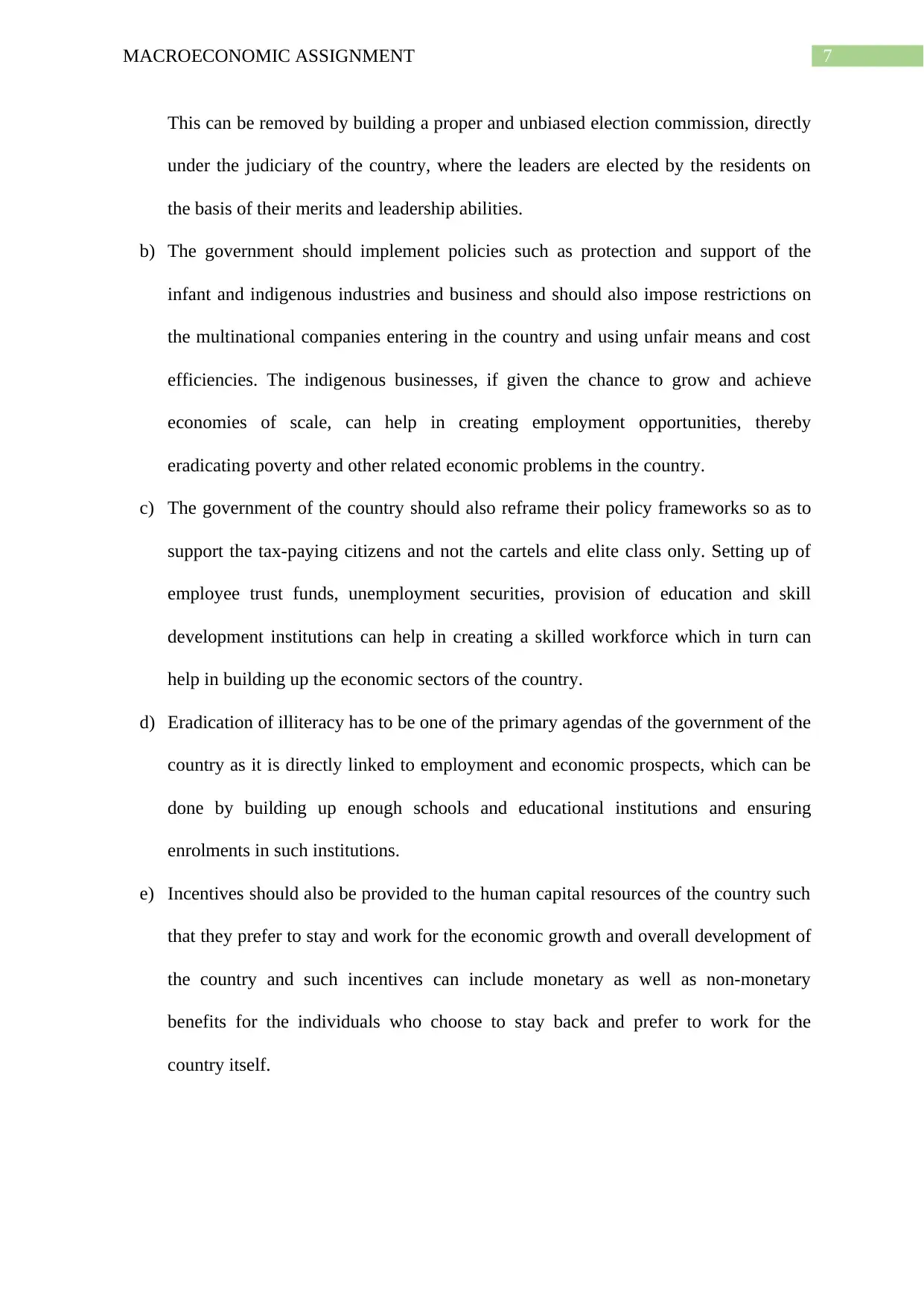
7MACROECONOMIC ASSIGNMENT
This can be removed by building a proper and unbiased election commission, directly
under the judiciary of the country, where the leaders are elected by the residents on
the basis of their merits and leadership abilities.
b) The government should implement policies such as protection and support of the
infant and indigenous industries and business and should also impose restrictions on
the multinational companies entering in the country and using unfair means and cost
efficiencies. The indigenous businesses, if given the chance to grow and achieve
economies of scale, can help in creating employment opportunities, thereby
eradicating poverty and other related economic problems in the country.
c) The government of the country should also reframe their policy frameworks so as to
support the tax-paying citizens and not the cartels and elite class only. Setting up of
employee trust funds, unemployment securities, provision of education and skill
development institutions can help in creating a skilled workforce which in turn can
help in building up the economic sectors of the country.
d) Eradication of illiteracy has to be one of the primary agendas of the government of the
country as it is directly linked to employment and economic prospects, which can be
done by building up enough schools and educational institutions and ensuring
enrolments in such institutions.
e) Incentives should also be provided to the human capital resources of the country such
that they prefer to stay and work for the economic growth and overall development of
the country and such incentives can include monetary as well as non-monetary
benefits for the individuals who choose to stay back and prefer to work for the
country itself.
This can be removed by building a proper and unbiased election commission, directly
under the judiciary of the country, where the leaders are elected by the residents on
the basis of their merits and leadership abilities.
b) The government should implement policies such as protection and support of the
infant and indigenous industries and business and should also impose restrictions on
the multinational companies entering in the country and using unfair means and cost
efficiencies. The indigenous businesses, if given the chance to grow and achieve
economies of scale, can help in creating employment opportunities, thereby
eradicating poverty and other related economic problems in the country.
c) The government of the country should also reframe their policy frameworks so as to
support the tax-paying citizens and not the cartels and elite class only. Setting up of
employee trust funds, unemployment securities, provision of education and skill
development institutions can help in creating a skilled workforce which in turn can
help in building up the economic sectors of the country.
d) Eradication of illiteracy has to be one of the primary agendas of the government of the
country as it is directly linked to employment and economic prospects, which can be
done by building up enough schools and educational institutions and ensuring
enrolments in such institutions.
e) Incentives should also be provided to the human capital resources of the country such
that they prefer to stay and work for the economic growth and overall development of
the country and such incentives can include monetary as well as non-monetary
benefits for the individuals who choose to stay back and prefer to work for the
country itself.
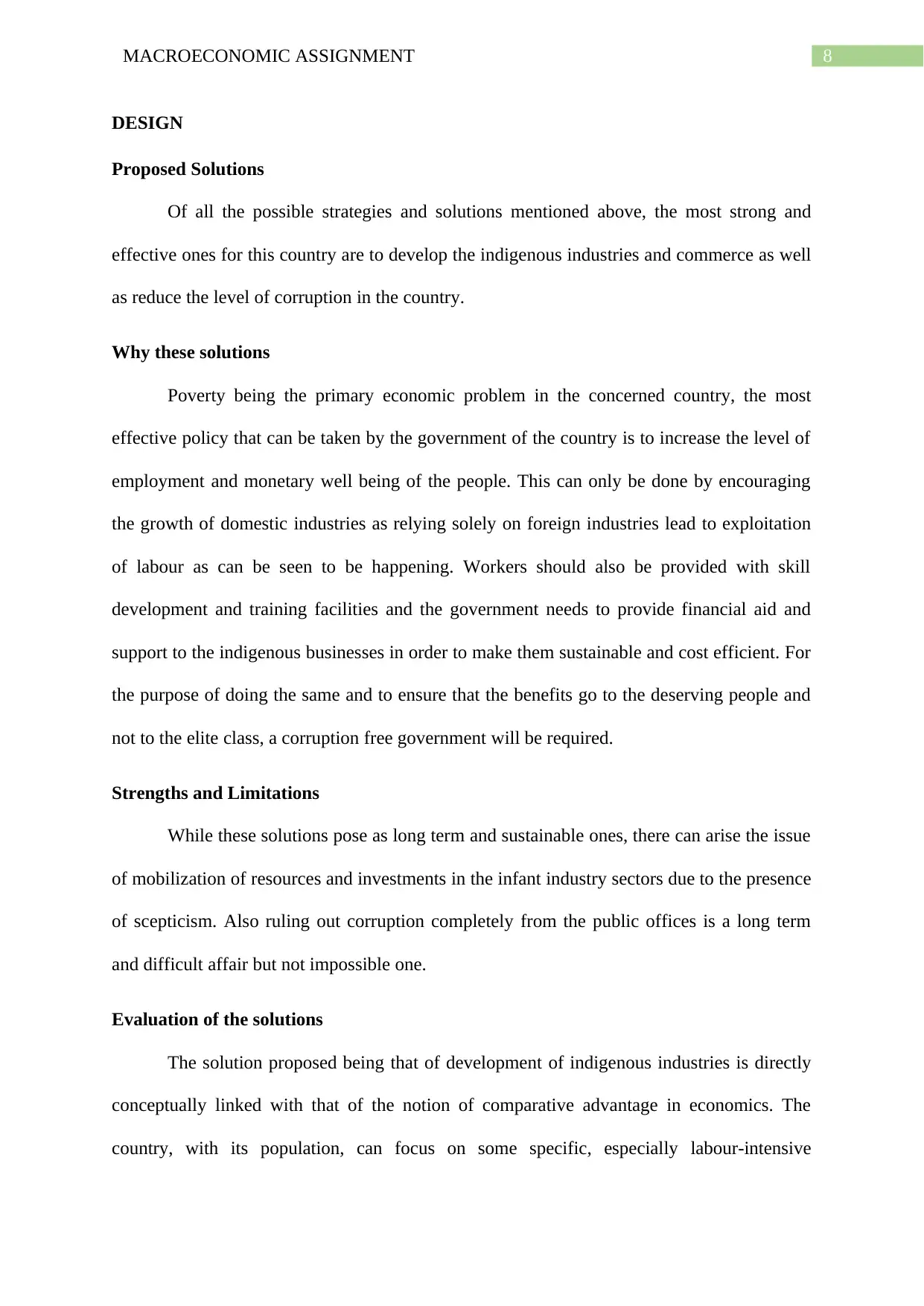
8MACROECONOMIC ASSIGNMENT
DESIGN
Proposed Solutions
Of all the possible strategies and solutions mentioned above, the most strong and
effective ones for this country are to develop the indigenous industries and commerce as well
as reduce the level of corruption in the country.
Why these solutions
Poverty being the primary economic problem in the concerned country, the most
effective policy that can be taken by the government of the country is to increase the level of
employment and monetary well being of the people. This can only be done by encouraging
the growth of domestic industries as relying solely on foreign industries lead to exploitation
of labour as can be seen to be happening. Workers should also be provided with skill
development and training facilities and the government needs to provide financial aid and
support to the indigenous businesses in order to make them sustainable and cost efficient. For
the purpose of doing the same and to ensure that the benefits go to the deserving people and
not to the elite class, a corruption free government will be required.
Strengths and Limitations
While these solutions pose as long term and sustainable ones, there can arise the issue
of mobilization of resources and investments in the infant industry sectors due to the presence
of scepticism. Also ruling out corruption completely from the public offices is a long term
and difficult affair but not impossible one.
Evaluation of the solutions
The solution proposed being that of development of indigenous industries is directly
conceptually linked with that of the notion of comparative advantage in economics. The
country, with its population, can focus on some specific, especially labour-intensive
DESIGN
Proposed Solutions
Of all the possible strategies and solutions mentioned above, the most strong and
effective ones for this country are to develop the indigenous industries and commerce as well
as reduce the level of corruption in the country.
Why these solutions
Poverty being the primary economic problem in the concerned country, the most
effective policy that can be taken by the government of the country is to increase the level of
employment and monetary well being of the people. This can only be done by encouraging
the growth of domestic industries as relying solely on foreign industries lead to exploitation
of labour as can be seen to be happening. Workers should also be provided with skill
development and training facilities and the government needs to provide financial aid and
support to the indigenous businesses in order to make them sustainable and cost efficient. For
the purpose of doing the same and to ensure that the benefits go to the deserving people and
not to the elite class, a corruption free government will be required.
Strengths and Limitations
While these solutions pose as long term and sustainable ones, there can arise the issue
of mobilization of resources and investments in the infant industry sectors due to the presence
of scepticism. Also ruling out corruption completely from the public offices is a long term
and difficult affair but not impossible one.
Evaluation of the solutions
The solution proposed being that of development of indigenous industries is directly
conceptually linked with that of the notion of comparative advantage in economics. The
country, with its population, can focus on some specific, especially labour-intensive
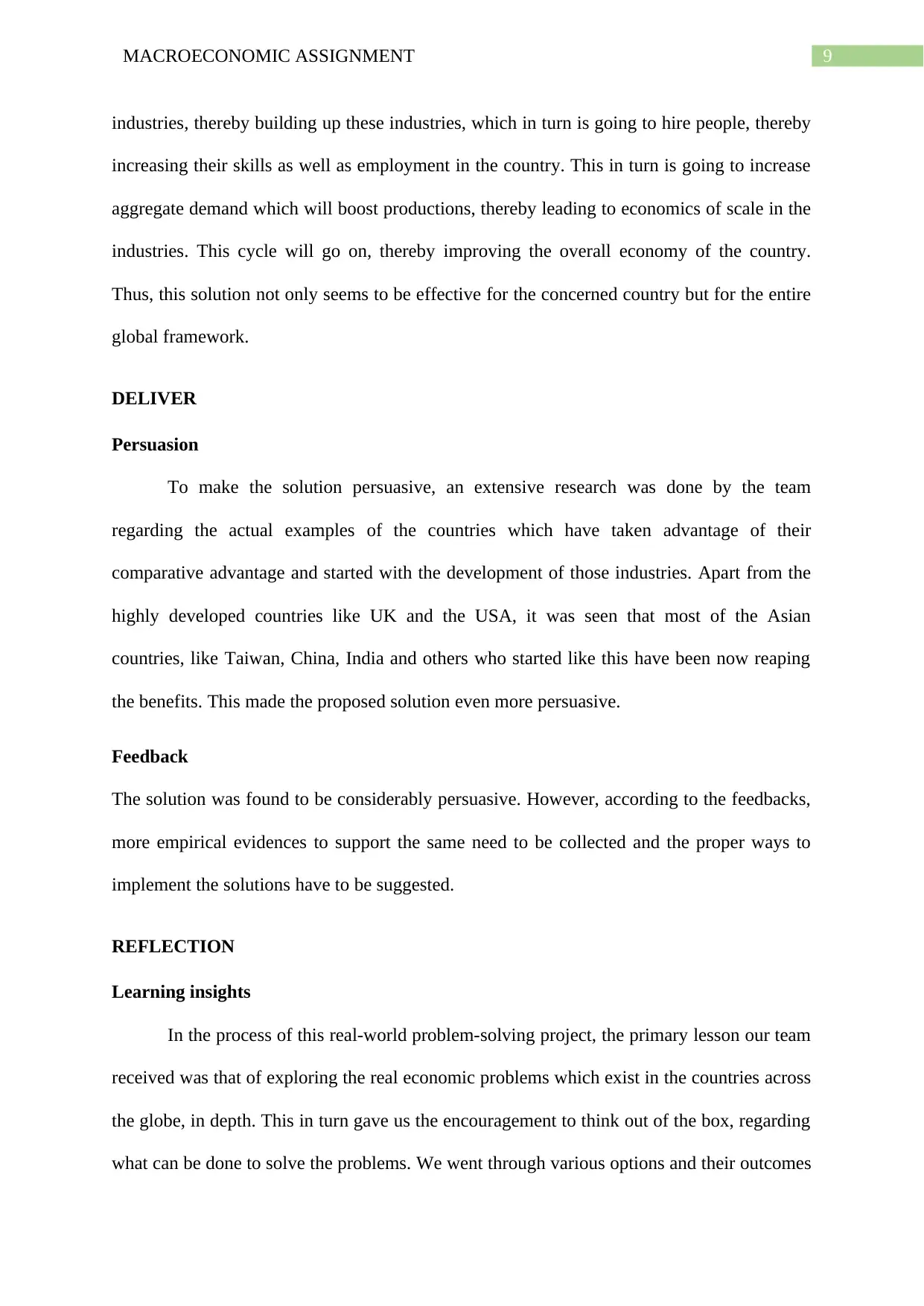
9MACROECONOMIC ASSIGNMENT
industries, thereby building up these industries, which in turn is going to hire people, thereby
increasing their skills as well as employment in the country. This in turn is going to increase
aggregate demand which will boost productions, thereby leading to economics of scale in the
industries. This cycle will go on, thereby improving the overall economy of the country.
Thus, this solution not only seems to be effective for the concerned country but for the entire
global framework.
DELIVER
Persuasion
To make the solution persuasive, an extensive research was done by the team
regarding the actual examples of the countries which have taken advantage of their
comparative advantage and started with the development of those industries. Apart from the
highly developed countries like UK and the USA, it was seen that most of the Asian
countries, like Taiwan, China, India and others who started like this have been now reaping
the benefits. This made the proposed solution even more persuasive.
Feedback
The solution was found to be considerably persuasive. However, according to the feedbacks,
more empirical evidences to support the same need to be collected and the proper ways to
implement the solutions have to be suggested.
REFLECTION
Learning insights
In the process of this real-world problem-solving project, the primary lesson our team
received was that of exploring the real economic problems which exist in the countries across
the globe, in depth. This in turn gave us the encouragement to think out of the box, regarding
what can be done to solve the problems. We went through various options and their outcomes
industries, thereby building up these industries, which in turn is going to hire people, thereby
increasing their skills as well as employment in the country. This in turn is going to increase
aggregate demand which will boost productions, thereby leading to economics of scale in the
industries. This cycle will go on, thereby improving the overall economy of the country.
Thus, this solution not only seems to be effective for the concerned country but for the entire
global framework.
DELIVER
Persuasion
To make the solution persuasive, an extensive research was done by the team
regarding the actual examples of the countries which have taken advantage of their
comparative advantage and started with the development of those industries. Apart from the
highly developed countries like UK and the USA, it was seen that most of the Asian
countries, like Taiwan, China, India and others who started like this have been now reaping
the benefits. This made the proposed solution even more persuasive.
Feedback
The solution was found to be considerably persuasive. However, according to the feedbacks,
more empirical evidences to support the same need to be collected and the proper ways to
implement the solutions have to be suggested.
REFLECTION
Learning insights
In the process of this real-world problem-solving project, the primary lesson our team
received was that of exploring the real economic problems which exist in the countries across
the globe, in depth. This in turn gave us the encouragement to think out of the box, regarding
what can be done to solve the problems. We went through various options and their outcomes
Secure Best Marks with AI Grader
Need help grading? Try our AI Grader for instant feedback on your assignments.
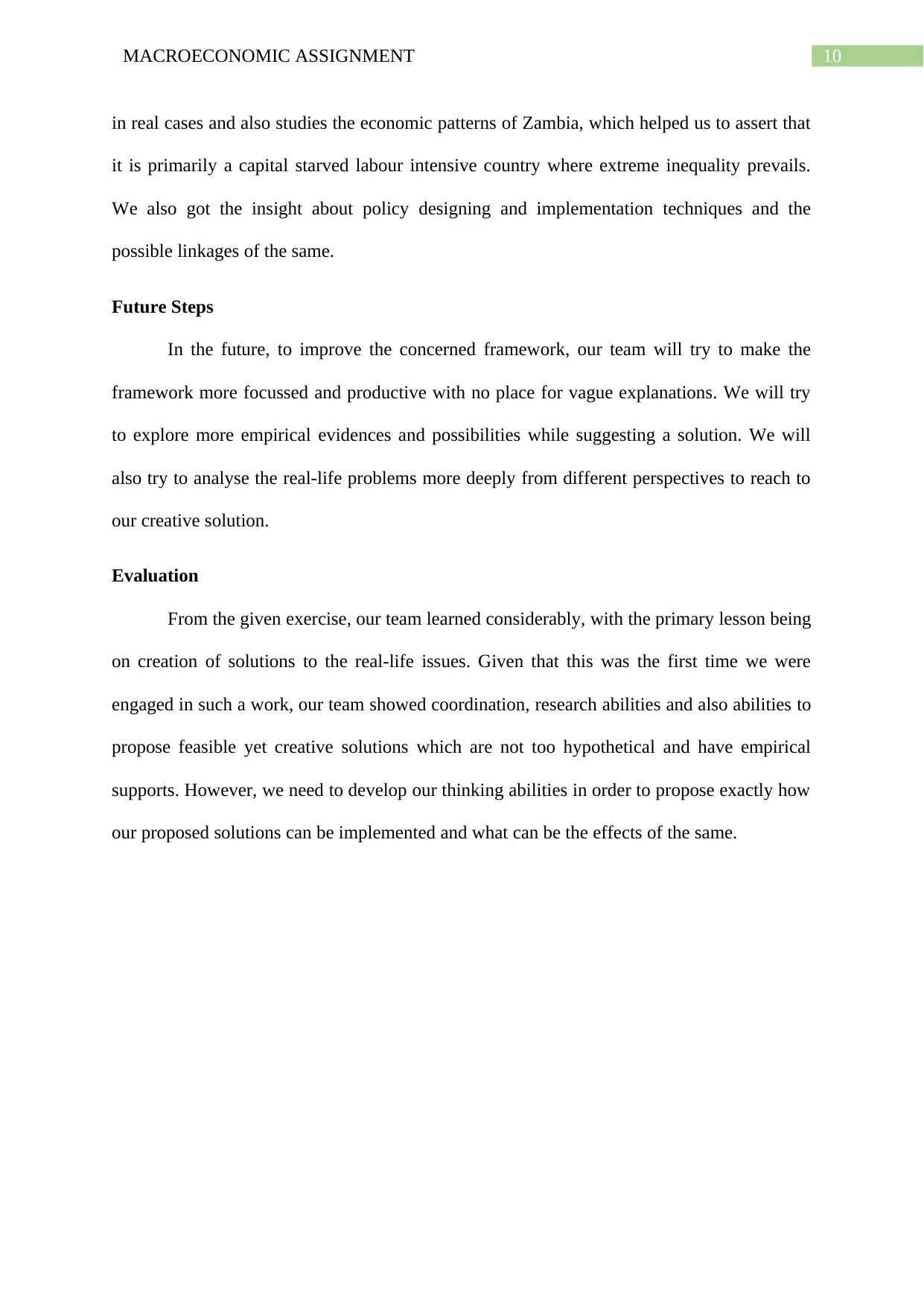
10MACROECONOMIC ASSIGNMENT
in real cases and also studies the economic patterns of Zambia, which helped us to assert that
it is primarily a capital starved labour intensive country where extreme inequality prevails.
We also got the insight about policy designing and implementation techniques and the
possible linkages of the same.
Future Steps
In the future, to improve the concerned framework, our team will try to make the
framework more focussed and productive with no place for vague explanations. We will try
to explore more empirical evidences and possibilities while suggesting a solution. We will
also try to analyse the real-life problems more deeply from different perspectives to reach to
our creative solution.
Evaluation
From the given exercise, our team learned considerably, with the primary lesson being
on creation of solutions to the real-life issues. Given that this was the first time we were
engaged in such a work, our team showed coordination, research abilities and also abilities to
propose feasible yet creative solutions which are not too hypothetical and have empirical
supports. However, we need to develop our thinking abilities in order to propose exactly how
our proposed solutions can be implemented and what can be the effects of the same.
in real cases and also studies the economic patterns of Zambia, which helped us to assert that
it is primarily a capital starved labour intensive country where extreme inequality prevails.
We also got the insight about policy designing and implementation techniques and the
possible linkages of the same.
Future Steps
In the future, to improve the concerned framework, our team will try to make the
framework more focussed and productive with no place for vague explanations. We will try
to explore more empirical evidences and possibilities while suggesting a solution. We will
also try to analyse the real-life problems more deeply from different perspectives to reach to
our creative solution.
Evaluation
From the given exercise, our team learned considerably, with the primary lesson being
on creation of solutions to the real-life issues. Given that this was the first time we were
engaged in such a work, our team showed coordination, research abilities and also abilities to
propose feasible yet creative solutions which are not too hypothetical and have empirical
supports. However, we need to develop our thinking abilities in order to propose exactly how
our proposed solutions can be implemented and what can be the effects of the same.
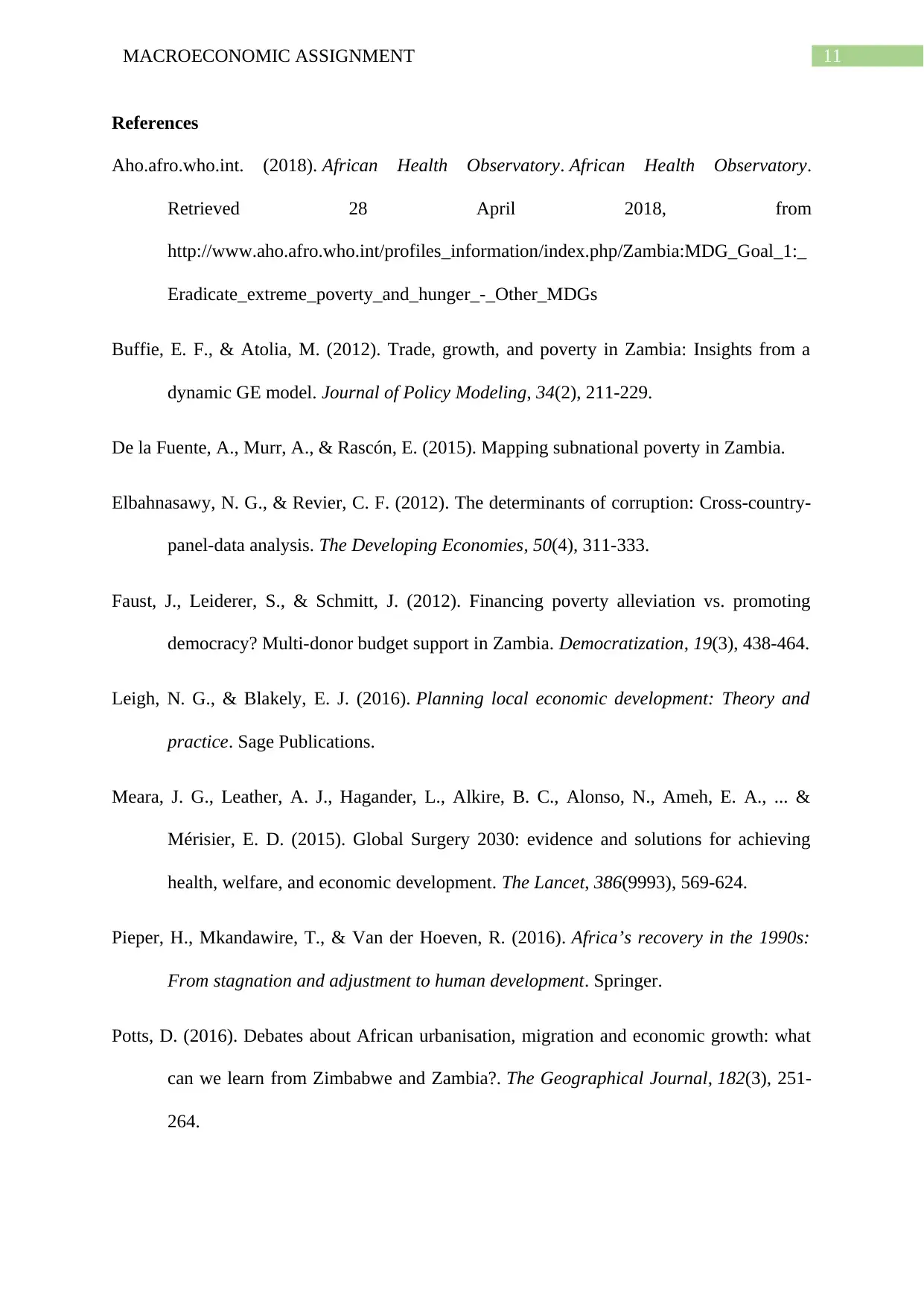
11MACROECONOMIC ASSIGNMENT
References
Aho.afro.who.int. (2018). African Health Observatory. African Health Observatory.
Retrieved 28 April 2018, from
http://www.aho.afro.who.int/profiles_information/index.php/Zambia:MDG_Goal_1:_
Eradicate_extreme_poverty_and_hunger_-_Other_MDGs
Buffie, E. F., & Atolia, M. (2012). Trade, growth, and poverty in Zambia: Insights from a
dynamic GE model. Journal of Policy Modeling, 34(2), 211-229.
De la Fuente, A., Murr, A., & Rascón, E. (2015). Mapping subnational poverty in Zambia.
Elbahnasawy, N. G., & Revier, C. F. (2012). The determinants of corruption: Cross‐country‐
panel‐data analysis. The Developing Economies, 50(4), 311-333.
Faust, J., Leiderer, S., & Schmitt, J. (2012). Financing poverty alleviation vs. promoting
democracy? Multi-donor budget support in Zambia. Democratization, 19(3), 438-464.
Leigh, N. G., & Blakely, E. J. (2016). Planning local economic development: Theory and
practice. Sage Publications.
Meara, J. G., Leather, A. J., Hagander, L., Alkire, B. C., Alonso, N., Ameh, E. A., ... &
Mérisier, E. D. (2015). Global Surgery 2030: evidence and solutions for achieving
health, welfare, and economic development. The Lancet, 386(9993), 569-624.
Pieper, H., Mkandawire, T., & Van der Hoeven, R. (2016). Africa’s recovery in the 1990s:
From stagnation and adjustment to human development. Springer.
Potts, D. (2016). Debates about African urbanisation, migration and economic growth: what
can we learn from Zimbabwe and Zambia?. The Geographical Journal, 182(3), 251-
264.
References
Aho.afro.who.int. (2018). African Health Observatory. African Health Observatory.
Retrieved 28 April 2018, from
http://www.aho.afro.who.int/profiles_information/index.php/Zambia:MDG_Goal_1:_
Eradicate_extreme_poverty_and_hunger_-_Other_MDGs
Buffie, E. F., & Atolia, M. (2012). Trade, growth, and poverty in Zambia: Insights from a
dynamic GE model. Journal of Policy Modeling, 34(2), 211-229.
De la Fuente, A., Murr, A., & Rascón, E. (2015). Mapping subnational poverty in Zambia.
Elbahnasawy, N. G., & Revier, C. F. (2012). The determinants of corruption: Cross‐country‐
panel‐data analysis. The Developing Economies, 50(4), 311-333.
Faust, J., Leiderer, S., & Schmitt, J. (2012). Financing poverty alleviation vs. promoting
democracy? Multi-donor budget support in Zambia. Democratization, 19(3), 438-464.
Leigh, N. G., & Blakely, E. J. (2016). Planning local economic development: Theory and
practice. Sage Publications.
Meara, J. G., Leather, A. J., Hagander, L., Alkire, B. C., Alonso, N., Ameh, E. A., ... &
Mérisier, E. D. (2015). Global Surgery 2030: evidence and solutions for achieving
health, welfare, and economic development. The Lancet, 386(9993), 569-624.
Pieper, H., Mkandawire, T., & Van der Hoeven, R. (2016). Africa’s recovery in the 1990s:
From stagnation and adjustment to human development. Springer.
Potts, D. (2016). Debates about African urbanisation, migration and economic growth: what
can we learn from Zimbabwe and Zambia?. The Geographical Journal, 182(3), 251-
264.
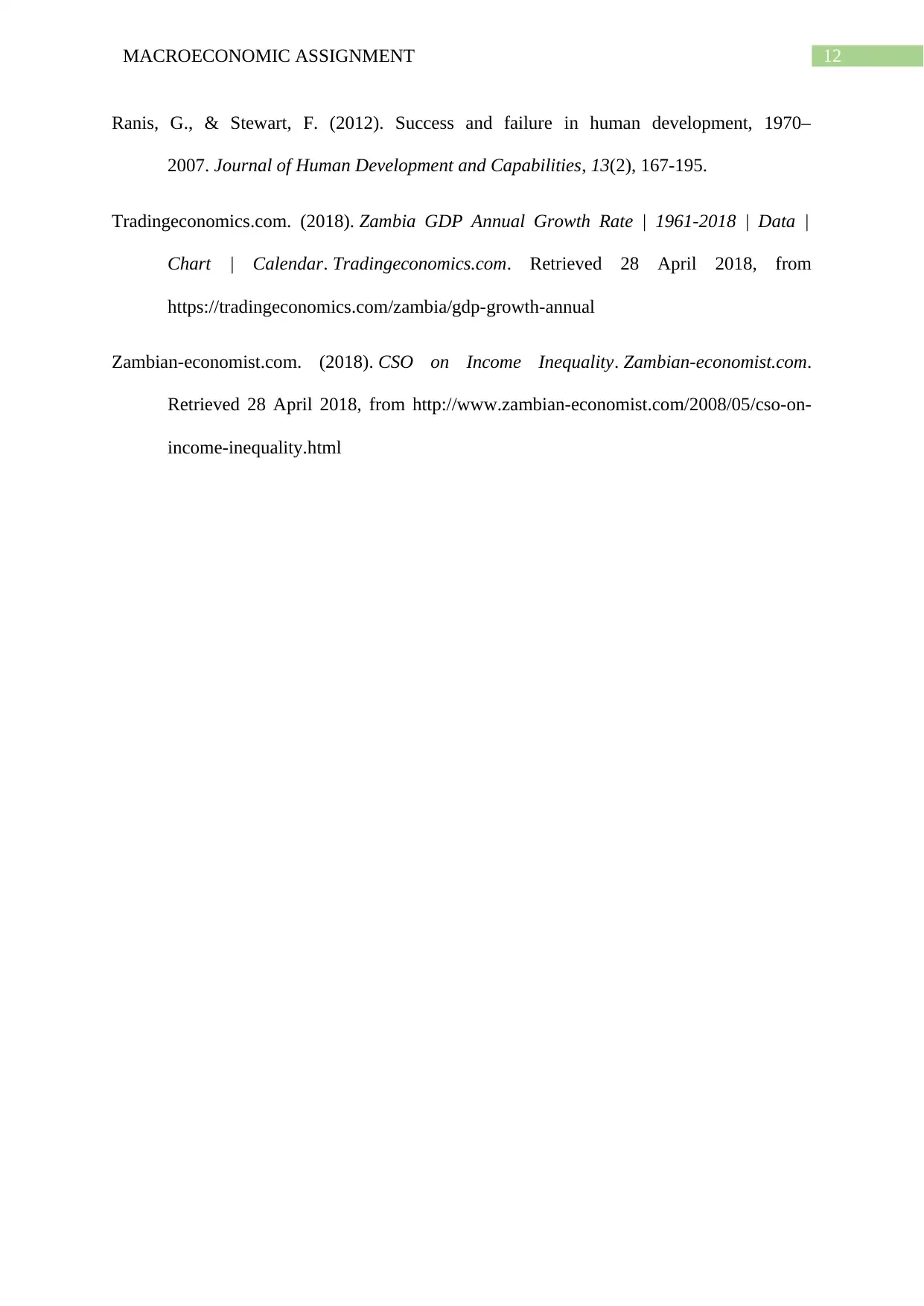
12MACROECONOMIC ASSIGNMENT
Ranis, G., & Stewart, F. (2012). Success and failure in human development, 1970–
2007. Journal of Human Development and Capabilities, 13(2), 167-195.
Tradingeconomics.com. (2018). Zambia GDP Annual Growth Rate | 1961-2018 | Data |
Chart | Calendar. Tradingeconomics.com. Retrieved 28 April 2018, from
https://tradingeconomics.com/zambia/gdp-growth-annual
Zambian-economist.com. (2018). CSO on Income Inequality. Zambian-economist.com.
Retrieved 28 April 2018, from http://www.zambian-economist.com/2008/05/cso-on-
income-inequality.html
Ranis, G., & Stewart, F. (2012). Success and failure in human development, 1970–
2007. Journal of Human Development and Capabilities, 13(2), 167-195.
Tradingeconomics.com. (2018). Zambia GDP Annual Growth Rate | 1961-2018 | Data |
Chart | Calendar. Tradingeconomics.com. Retrieved 28 April 2018, from
https://tradingeconomics.com/zambia/gdp-growth-annual
Zambian-economist.com. (2018). CSO on Income Inequality. Zambian-economist.com.
Retrieved 28 April 2018, from http://www.zambian-economist.com/2008/05/cso-on-
income-inequality.html
1 out of 13
Related Documents
Your All-in-One AI-Powered Toolkit for Academic Success.
+13062052269
info@desklib.com
Available 24*7 on WhatsApp / Email
![[object Object]](/_next/static/media/star-bottom.7253800d.svg)
Unlock your academic potential
© 2024 | Zucol Services PVT LTD | All rights reserved.
